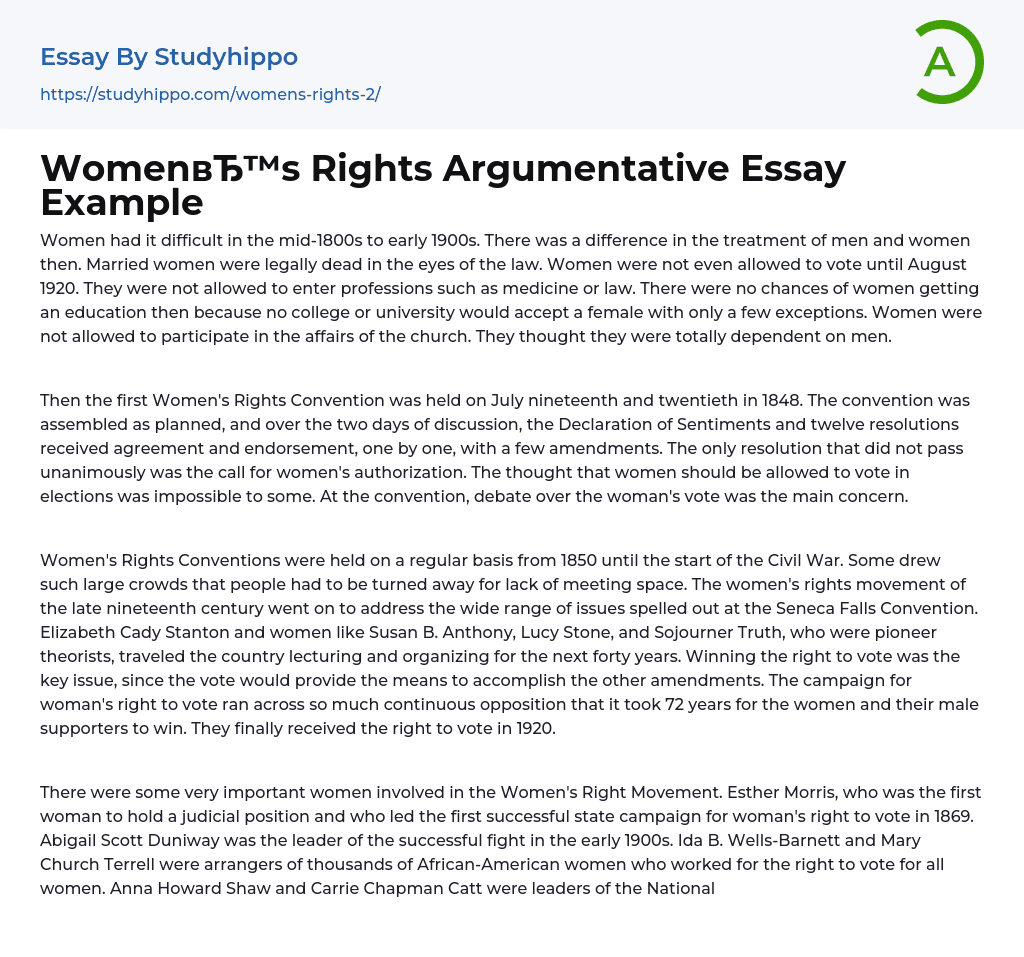During the mid-1800s to early 1900s, women encountered major obstacles. They experienced distinct treatment compared to men during this era. Legally, married women had no legal status. Moreover, until August 1920, they were deprived of suffrage and forbidden from pursuing professions in areas such as medicine and law. Access to education was also restricted for most women, with only a handful of colleges or universities admitting female students, except for rare cases. Additionally, women were excluded from involvement in church affairs, rendering them completely reliant on men.
The first Women's Rights Convention took place on July 19th and 20th, 1848. The convention proceeded as planned and concluded with a unanimous endorsement of the Declaration of Sentiments and twelve resolutions after two days of discussion. However, some amendments were made to these resolutions. The only resolution that did not receive
...unanimous support was the one advocating for women's suffrage, as certain individuals believed it would be impossible to grant women the right to vote in elections. Consequently, women's voting rights emerged as the main topic of debate during the convention.
Women's Rights Conventions were regularly held from 1850 until the start of the Civil War, with some gatherings becoming so popular that lack of meeting space led to people being turned away. The women's rights movement in the late nineteenth century then addressed the various issues outlined at the Seneca Falls Convention.
Elizabeth Cady Stanton, along with pioneering theorists like Susan B. Anthony, Lucy Stone, and Sojourner Truth, spent four decades traveling across the country giving lectures and organizing. Their primary focus was securing the right to vote, which would enable them to achieve other amendments.
Despite continuous opposition, it
took 72 years for these women and their male supporters to finally win the right to vote in 1920.
The Women's Right Movement was advanced by several influential women. Esther Morris, the first woman to hold a judicial position, spearheaded the successful state campaign for women's suffrage in 1869. Abigail Scott Duniway led the victorious battle for women's rights in the early 1900s. Ida B. Wells-Barnett and Mary Church Terrell organized numerous African-American women who tirelessly fought for universal suffrage. Anna Howard Shaw and Carrie Chapman Catt, leaders of the National American Woman Suffrage Association during the early 20th century, played an instrumental role in leading the movement to its ultimate victory. These remarkable women are the driving force behind achieving women's rights in the United States and can be rightfully considered as the founding mothers of this nation.
- Sojourner Truth essays
- John Locke essays
- 9/11 essays
- A Good Teacher essays
- A Healthy Diet essays
- A Modest Proposal essays
- A&P essays
- Academic Achievement essays
- Achievement essays
- Achieving goals essays
- Admission essays
- Advantages And Disadvantages Of Internet essays
- Alcoholic drinks essays
- Ammonia essays
- Analytical essays
- Ancient Olympic Games essays
- APA essays
- Arabian Peninsula essays
- Argument essays
- Argumentative essays
- Art essays
- Atlantic Ocean essays
- Auto-ethnography essays
- Autobiography essays
- Ballad essays
- Batman essays
- Binge Eating essays
- Black Power Movement essays
- Blogger essays
- Body Mass Index essays
- Book I Want a Wife essays
- Boycott essays
- Breastfeeding essays
- Bulimia Nervosa essays
- Business essays
- Business Process essays
- Canterbury essays
- Carbonate essays
- Catalina de Erauso essays
- Cause and Effect essays
- Cesar Chavez essays
- Character Analysis essays
- Chemical Compound essays
- Chemical Element essays
- Chemical Substance essays
- Cherokee essays
- Cherry essays
- Childhood Obesity essays
- Chlorine essays
- Classification essays




